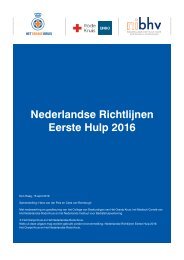Thesis-Anne-Vos-Masters-SBR-and-EU-Law-3
Thesis-Anne-Vos-Masters-SBR-and-EU-Law-3
Thesis-Anne-Vos-Masters-SBR-and-EU-Law-3
You also want an ePaper? Increase the reach of your titles
YUMPU automatically turns print PDFs into web optimized ePapers that Google loves.
On the other h<strong>and</strong>, it should be realised that the precautionary principle is not per se good from all<br />
perspectives. According to Fleming, “[u]nrealisticly high dem<strong>and</strong>s on the removal of uncertainty<br />
suffocate the balancing of energy security interests with environmental protection dem<strong>and</strong>s, since<br />
a prerequisite for the weighting is a certain amount of leeway in which it can be performed.” 425 He<br />
illustrates this by referring to the precautionary moratorium on natural gas drilling in the Wadden<br />
Sea in 1999. The Dutch government stated that as long as any uncertainties regarding possibly<br />
permanent degradation of the Wadden Sea existed (to a certain extent), no permits would be<br />
issued. Difficulties arose as how much (un)certainty was required <strong>and</strong> what ‘to a certain extent’<br />
meant. The statement of the government referred to ‘any uncertainties’ which is impossible to<br />
reach in practice. What could be learnt from this experience, according to Fleming, is that<br />
thresholds should not be set too high. Some risks are inevitable, otherwise new technologies could<br />
never be tried out, as Fleming points out. He states that such a high threshold would make the<br />
balancing exercise between energy security <strong>and</strong> environmental protection impossible. 426 He argues<br />
that if no fear of significant harm exists, the precautionary principle is already sufficiently fulfilled.<br />
This line of reasoning (of Fleming) could in general be followed. However, it could be noted that<br />
this consideration might not be true for every situation. Therefore, it could be argued that the<br />
reasoning of Fleming should take a more casuistic approach. In the case of shale gas exploration,<br />
this line of reasoning could be questioned, especially with regard to the adverse effects for drinking<br />
water for which there are no alternatives available, as elaborated further in paragraph 6.4.3.<br />
On the Dutch level, there is also another development of relevance; the adoptive licensing<br />
approach. The ABRvS seems to not explicitly review measures or decisions against the<br />
precautionary principle itself, but on the basis of this approach. It is very well possible that the<br />
Minister of Economic Affairs will adopt a system in which such a monitoring plan is built-in. It must<br />
be kept in mind that a monitoring system is only acceptable if the margin for which it provides<br />
concerns a remaining manageable residual risk, the monitoring relates specifically to that risk <strong>and</strong><br />
there is no alternative to exclude that risk. Moreover, it is still questionable whether the Court of<br />
Justice would accept this line of reasoning. Therefore, such a system would not be preferable.<br />
6.4.2 The prevention principle<br />
The prevention principle should be distinguished from the precautionary principle. While the<br />
precautionary principle can be invoked if there is no scientific certainty, the prevention principle can<br />
only be invoked if the adverse effects for the environment are objectively established. The level of<br />
certainty is thus decisive. With regard to shale gas activities it may be dependent on the certain<br />
risks that are discussed; some risks are more uncertain than others. In practice, the principles are<br />
almost always invoked together. Another important difference between the two (with regard to<br />
shale gas activities) is that the prevention principle applies a definition of an acceptable risk that is<br />
primarily science based, while the precautionary principle considers the social acceptance of the<br />
risk. The social acceptance is an important matter with regard to shale gas activities, in the sense<br />
that there is none (or not much). This produces a high threshold for shale gas regulation.<br />
An important duty required by the prevention principle is that competent authorities may not limit<br />
themselves to certain concepts or list, but should always take a broader view in the interest of<br />
preventing or mitigating environmental degradation. Hence, competent authorities should be openminded.<br />
Here, the current approach of the Dutch government provides for a good example. In the<br />
Draft MSL certain zones are excluded from shale gas extraction, while others are not. The Minister<br />
depends its decision thereon on the currently existing (Dutch) regulation on e.g. the Mining Act, the<br />
Water Act, etc. Therefore, the Minister has decided for example not to exclude boring free zones<br />
from shale gas activities, because they are not in contrast with the Model PMV. This is an example<br />
425<br />
Fleming (2014), p. 26.<br />
426<br />
Fleming (2014), p. 27.<br />
90



